Philip K. Dick paperback covers (Panther Science Fiction)
Over almost two decades, Roslyn Gothic graced dozens of covers with works by the writer, building a visual identity for the master of dystopian fiction.
![Now Wait for Last Year (1975). Cover art by Chris Foss. [More info on ISFDB]](https://assets.fontsinuse.com/static/use-media-items/141/140747/upto-700xauto/60c5bf9b/7987217685_d2fc374ae7_o_d.png)
Now Wait for Last Year (1975). Cover art by Chris Foss. [More info on ISFDB]
Roslyn Gothic arguably saw its most extensive and iconic use on the paperback covers with works by Philip K. Dick as published by Panther Books.
Designed by Harry Winters, Roslyn Gothic was released by Visual Graphics Corporation (VGC) in 1972, to be used with their Photo Typositor, a popular display typesetting machine of the phototype era. There were three styles; Medium, Bold, and Outline. The sans serif of condensed proportions is infused with some traits that seem to harken back to Art Nouveau, or Jugendstil: counters in d, g, or p are tear-shaped, e has a diagonal bar while the top arm of K is vertical, some stems in m, n, u are slightly curved, A is asymmetrical, and G is pointed at the bottom. Several of these features can also be found in German typefaces from around 1900, like Sezessions-Grotesk or Skulptur. By giving his design a large x-height and tight letterspacing, Winters turned these influences into a quintessential 1970s display typeface. With its punchy yet slightly alien-looking shapes, Roslyn Gothic became a popular choice on book covers in the science fiction genre.

Roslyn Gothic and its designer, Harry Winters, as shown in Industrial Art Methods, December 1972. Roslyn Gothic isn’t yet shown in a VGC catalog dated 1972, indicating it must have been new when the magazine came out.
As it was common with other publishers, too, Panther didn’t use a single typeface for all of their science fiction releases, but rather assigned a certain typeface to each author, building multiple sub-identities to increase their recognizability: Kabel Black for Asimov, City for Ursula K. LeGuin, American Uncial for Brian W. Aldiss, etc. The face chosen for Philip K. Dick was Roslyn Gothic Bold. The first of Dick’s paperbacks with Roslyn Gothic on the cover were issued in 1975. This choice was maintained at least until 1992.
Established in 1952, Panther Books Ltd. was a British publisher specializing in paperback fiction. By 1968, it had been acquired by Granada Group Ltd., making it a subsidiary company of Granada Publishing Ltd., and Panther Science Fiction a Granada imprint. Some of the shown books were published under other Granada imprints, including Triad Panther, or Grafton.
![The Zap Gun (1975). Cover art by Peter Andrew Jones. [More info on ISFDB]
The typeface used for “Hugo Award-winning author” between 1975 and 1980 is a version of Condensed. It sometimes appears with the standard double-storey g, sometimes with a single-storey form, and occasionally with both, in changing positions. I wonder whether this was some sort of running gag among the typesetters.](https://assets.fontsinuse.com/static/use-media-items/141/140744/upto-700xauto/60cf18f0/7936039020_7a962ef2e9_o_d.png)
The Zap Gun (1975). Cover art by Peter Andrew Jones. [More info on ISFDB]
The typeface used for “Hugo Award-winning author” between 1975 and 1980 is a version of News Gothic Condensed. It sometimes appears with the standard double-storey g, sometimes with a single-storey form, and occasionally with both, in changing positions. I wonder whether this was some sort of running gag among the typesetters.
In 1990, Garrett Boge of LetterPerfect digitized the boldest weight as Roslyn Gothic LP Bold. Mecanorma’s digital version, Roslyn, covers all three styles. Released by Red Rooster in 2010, Ryder Gothic is a reinterpretation by Steve Jackaman and Ashley Muir that adds a new light weight and several alternate glyphs. [There’s a fourth digitization by Panache Graphics, see comments.]
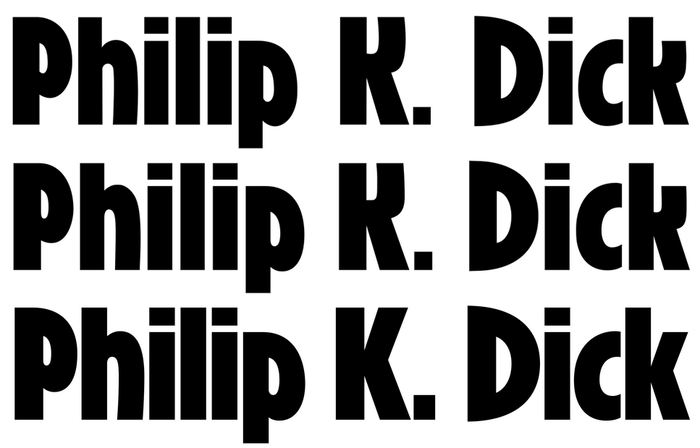
Three digital revivals of Roslyn Gothic Bold. From top to bottom:
1. Roslyn Gothic LP Regular (LetterPerfect, 1990)
2. Roslyn MN Bold (ITF Mecanorma)
3. Ryder Gothic Pro Bold (Red Rooster, 2010)
![Clans of the Alphane Moon (1975). Cover art by Peter Andrew Jones. [More info on ISFDB]](https://assets.fontsinuse.com/static/use-media-items/141/140755/upto-700xauto/60cf13a3/3095472387_dcc7bbcbd7_o_d.jpeg)
Clans of the Alphane Moon (1975). Cover art by Peter Andrew Jones. [More info on ISFDB]
![Flow My Tears, the Policeman Said (1976). Cover art by Richard Clifton-Dey. [More info on ISFDB]](https://assets.fontsinuse.com/static/use-media-items/141/140752/upto-700xauto/60cf13a3/3095428501_3f5c9b33ac_o_d.jpeg)
Flow My Tears, the Policeman Said (1976). Cover art by Richard Clifton-Dey. [More info on ISFDB]
![Our Friends from Frolix 8 (1976). Cover art by Jim Burns. [More info on ISFDB]](https://assets.fontsinuse.com/static/use-media-items/141/140754/upto-700xauto/60cf13a4/2729449107_ef480d744e_o_d.jpeg)
Our Friends from Frolix 8 (1976). Cover art by Jim Burns. [More info on ISFDB]
![Do Androids Dream of Electric Sheep? (1977). Cover art by Peter Goodfellow. [More info on ISFDB]](https://assets.fontsinuse.com/static/use-media-items/141/140796/upto-700xauto/60cf13a4/1028162219_381106e1a7_o_d.jpeg)
Do Androids Dream of Electric Sheep? (1977). Cover art by Peter Goodfellow. [More info on ISFDB]
![A Scanner Darkly (1978). [More info on ISFDB] The Brian Aldiss quote is set in .](https://assets.fontsinuse.com/static/use-media-items/141/140737/upto-700xauto/60cf13a4/7936042388_cdd73c5f12_o_d.png)
A Scanner Darkly (1978). [More info on ISFDB] The Brian Aldiss quote is set in Impact.
![Ubik (1978). Cover art by Ian Robertson. [More info on ISFDB]](https://assets.fontsinuse.com/static/use-media-items/141/140801/upto-700xauto/60cf13a4/1e401f2de2140a5353156c552f591171.jpeg)
Ubik (1978). Cover art by Ian Robertson. [More info on ISFDB]
![The Three Stigmata of Palmer Eldritch (1978). Cover art by Peter Gudynas. [More info on ISFDB]](https://assets.fontsinuse.com/static/use-media-items/141/140751/upto-700xauto/60cf13a4/7824032432_d0b62375f7_o_d.png)
The Three Stigmata of Palmer Eldritch (1978). Cover art by Peter Gudynas. [More info on ISFDB]
![The Penultimate Truth, 1978. Cover art by Peter Goodfellow. [More info on ISFDB]](https://assets.fontsinuse.com/static/use-media-items/141/140748/upto-700xauto/60cf13a4/7823954724_7399aae06a_o_d.png)
The Penultimate Truth, 1978. Cover art by Peter Goodfellow. [More info on ISFDB]
![A Handful of Darkness (1980). Cover art by Colin Hay. [More info on ISFDB]](https://assets.fontsinuse.com/static/use-media-items/141/140797/upto-700xauto/60cf13a4/91b3fJwL3WL.jpeg)
A Handful of Darkness (1980). Cover art by Colin Hay. [More info on ISFDB]
![Martian Time Slip (1983). Cover art by by . [More info on ISFDB]](https://assets.fontsinuse.com/static/use-media-items/163/162548/upto-700xauto/62751e65/8495139686_9ac274b92d_o_d.png)
Martian Time Slip (1983). Cover art by by Gerry Grace. [More info on ISFDB]
![The Transmigration of Timothy Archer (1983). Cover art by by George Underwood. [More info on ISFDB]
The secondary typeface here is all-caps .](https://assets.fontsinuse.com/static/use-media-items/141/140749/upto-700xauto/60cf13a4/7824732538_94b4db2f69_o_d.png)
The Transmigration of Timothy Archer (1983). Cover art by by George Underwood. [More info on ISFDB]
The secondary typeface here is all-caps Franklin Gothic.
![Lies, Inc. (1985). Cover art by Trevor Webb. [More info on ISFDB]](https://assets.fontsinuse.com/static/use-media-items/141/140746/upto-700xauto/60cf13a4/8088460234_842061b8f0_o_d.png)
Lies, Inc. (1985). Cover art by Trevor Webb. [More info on ISFDB]
![A Maze of Death (1984). Cover art by Tim Gill. [More info on ISFDB]](https://assets.fontsinuse.com/static/use-media-items/141/140800/upto-700xauto/60cf13a4/50752395948_24c9751cc7_o_d.jpeg)
A Maze of Death (1984). Cover art by Tim Gill. [More info on ISFDB]
![A Scanner Darkly (1985). Cover art by Trevor Webb. [More info on ISFDB]](https://assets.fontsinuse.com/static/use-media-items/141/140738/upto-700xauto/60cf13a4/713wVgIJnZL.jpeg)
A Scanner Darkly (1985). Cover art by Trevor Webb. [More info on ISFDB]
![We Can Build You (1986, reprinted 1988). Cover art by Chris Foss. [More info on ISFDB]](https://assets.fontsinuse.com/static/use-media-items/141/140756/upto-700xauto/60cf13a4/3116003036_2579b3f704_o_d.jpeg)
We Can Build You (1986, reprinted 1988). Cover art by Chris Foss. [More info on ISFDB]
![Galactic Pot-Healer (1987). Cover art by by Gino D’Achille. [More info on ISFDB]](https://assets.fontsinuse.com/static/use-media-items/141/140799/upto-700xauto/60cf13a5/Philip-K-Dick-Galactic-Pot-Healer-cover.jpeg)
Galactic Pot-Healer (1987). Cover art by by Gino D’Achille. [More info on ISFDB]
![The Preserving Machine (1987). Cover art by Chris Foss. [More info on ISFDB]](https://assets.fontsinuse.com/static/use-media-items/141/140798/upto-700xauto/60cf13a5/f161c19df6e917857f95eae65ad0141b.jpeg)
The Preserving Machine (1987). Cover art by Chris Foss. [More info on ISFDB]
![Radio Free Albemuth (1988). Cover art by Tony Roberts. [More info on ISFDB]](https://assets.fontsinuse.com/static/use-media-items/141/140745/upto-700xauto/60cf13a5/7824757628_d9c8927e16_o_d.png)
Radio Free Albemuth (1988). Cover art by Tony Roberts. [More info on ISFDB]
![I Hope I Shall Arrive Soon (1988). Cover art by Chris Foss. [More info on ISFDB]](https://assets.fontsinuse.com/static/use-media-items/141/140809/upto-700xauto/60cf13a5/I-Hope-I-Shall-Arrive-Soon.jpeg)
I Hope I Shall Arrive Soon (1988). Cover art by Chris Foss. [More info on ISFDB]
![The Divine Invasion (1989). Cover art by Chris Foss. [More info on ISFDB]](https://assets.fontsinuse.com/static/use-media-items/141/140810/upto-700xauto/60cf13a5/BKTG01506.jpeg)
The Divine Invasion (1989). Cover art by Chris Foss. [More info on ISFDB]
![Valis (1992). Cover art by Chris Moore. [More info on ISFDB]](https://assets.fontsinuse.com/static/use-media-items/141/140802/upto-700xauto/60cf13a5/BKTG01589.jpeg)
Valis (1992). Cover art by Chris Moore. [More info on ISFDB]
![Counter-Clock World (1990). Cover art by Chris Moore. [More info on ISFDB]](https://assets.fontsinuse.com/static/use-media-items/141/140811/upto-700xauto/60cf13a5/93WD_AS-W29jXlvNRy1FteZUZtZSd6HADMAuInCu7-s.jpeg)
Counter-Clock World (1990). Cover art by Chris Moore. [More info on ISFDB]
![The Game-Players Of Titan (1991). Cover art by Chris Moore. [More info on ISFDB]](https://assets.fontsinuse.com/static/use-media-items/141/140812/upto-700xauto/60cf13a5/the-game--players-of-titan-cover.jpeg)
The Game-Players Of Titan (1991). Cover art by Chris Moore. [More info on ISFDB]
![The Three Stigmata of Palmer Eldritch (1992). Cover art by Chris Moore. [More info on ISFDB]](https://assets.fontsinuse.com/static/use-media-items/141/140813/upto-700xauto/60cf13a5/The-Three-Stigmata-of-Palmer-Eldritch.jpeg)
The Three Stigmata of Palmer Eldritch (1992). Cover art by Chris Moore. [More info on ISFDB]
Formats
- Books (5423)
- Branding/Identity (6667)
Topics
- Literature (2505)
- Science/Nature (909)
Designers/Agencies
- Chris Foss (8)
- Peter Andrew Jones (1)
- Richard Clifton-Dey (1)
- Jim Burns (2)
- Peter Goodfellow (2)
- Ian Robertson (1)
- Peter Gudynas (1)
- Colin Hay (1)
- George Underwood (4)
- Trevor Webb (1)
- Tim Gill (1)
- Gino D’Achille (2)
- Tony Roberts (1)
- Chris Moore (2)
- Gerry Grace (2)
Tagged with
- Philip K. Dick (13)
- Panther Books (8)
- book series (428)
- paperbacks/softcovers (1490)
- book covers (4795)
- science fiction (407)
- dystopian (50)
- reversed type on an image (1018)
- long-time use (118)
- high profile (582)
- space travel (116)
- spacecraft (41)
- novels (539)
- short stories (101)
- eyes (132)
- skulls (90)
- sheep (19)
- blurbs (152)
- Brian W. Aldiss (2)
- typeface profile (82)
- iconic uses (104)
- alternate glyphs (1134)
- A Maze of Death (2)
- Do Androids Dream of Electric Sheep? (5)
- Martian Time-Slip (1)
Artwork location
- United Kingdom (2760)
- London (1521)








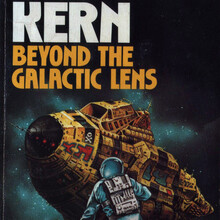


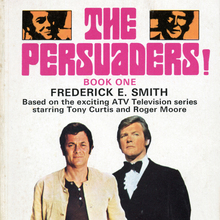


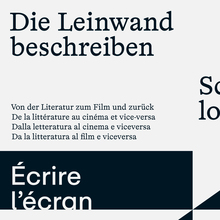






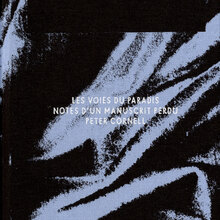



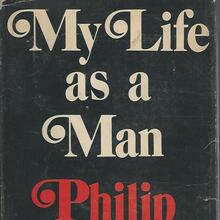





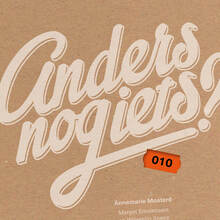















6 Comments on “Philip K. Dick paperback covers (Panther Science Fiction)”
the lowercase /r/ is so wild
Isn’t it? The longer one looks, the more glyphs pop up that are bonkers. I would have assumed that you can’t really have pointed terminals with a chunky and compact extrabold. And if you had a pointed N, the A would need to be pointed too. Or that you can’t get away with (more or less) flipping the M to make a W. But no – it all falls into place just nicely.
It came to my attention that there’s a fourth digitization of Roslyn Gothic, made around 1992 by Dave Farey for Panache Graphics, and spanning the Medium and Bold weights. It’s available from FontHaus.
I can offer another version of A Handful of Darkness: second row, third from the left in my collection.
That’s cool, thank you, Alexis! That’s the 1988 edition with cover art by Chris Foss. Your image also shows The Cosmic Puppets (1985, cover art by Steve Crisp), fifth in the first row, which is likewise missing from the article.
The shown selection is not exhaustive; at some point I stopped. Among the omitted ones are several from the 1990s where the type is shown smaller. These include The Father-Thing (1990), Second Variety (1990), Beyond Lies the Wub (1990), The Days of Perky Pat (1991), We Can Remember It for You Wholesale (1991), and the 1992 printings of A Maze of Death and The Penultimate Truth (all with cover art by Chris Moore).
Years ago I went on a PKD reading binge, my first novel was a Panther/Grafton issue and the art and font really sold me on it.